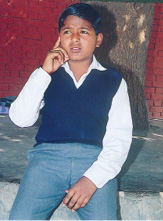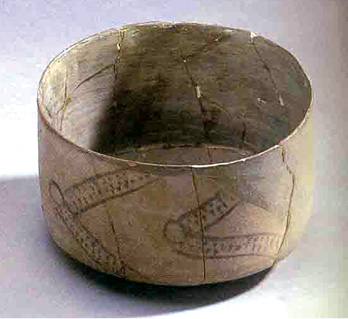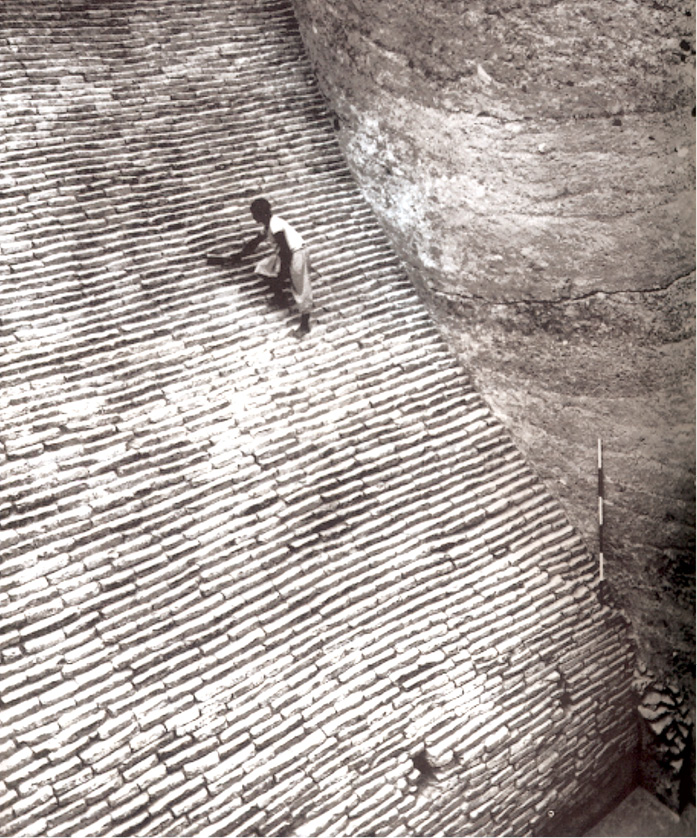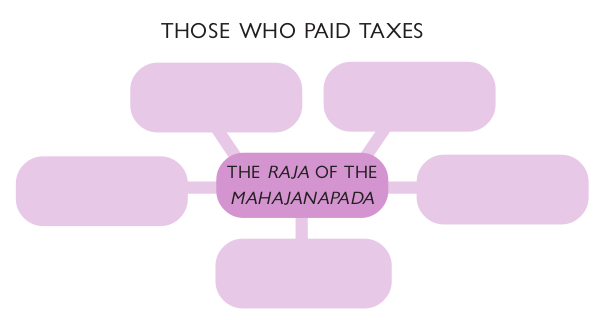Table of Contents
CHAPTER 5
KINGDOMS, KINGS AND AN EARLY REPUBLIC
Election day
Shankaran woke up to see his grandparents all ready to go and vote. They wanted to be the first to reach the polling booth. Why, Shankaran wanted to know, were they so excited? Somewhat impatiently, his grandfather explained: “We can choose our own rulers today.”

How some men became rulers
Choosing leaders or rulers by voting is something that has become common during the last fifty years or so. How did men become rulers in the past? Some of the rajas we read about in Chapter 4 were probably chosen by the jana, the people. But, around 3000 years ago, we find some changes taking place in the ways in which rajas were chosen. Some men now became recognised as rajas by performing very big sacrifices.
The ashvamedha or horse sacrifice was one such ritual. A horse was let loose to wander freely and it was guarded by the raja’s men. If the horse wandered into the kingdoms of other rajas and they stopped it, they had to fight. If they allowed the horse to pass, it meant that they accepted that the raja who wanted to perform the sacrifice was stronger than them. These rajas were then invited to the sacrifice, which was performed by specially trained priests, who were rewarded with gifts. The raja who organised the sacrifice was recognised as being very powerful, and all those who came brought gifts for him.
The raja was a central figure in these rituals. He often had a special seat, a throne or a tiger skin. His charioteer, who was his companion in the battle field and witnessed his exploits, chanted tales of his glory. His relatives, especially his wives and sons, had to perform a variety of minor rituals. The other rajas were simply spectators who had to sit and watch the performance of the sacrifice. Priests performed the rituals including the sprinkling of sacred water on the king. The ordinary people, the vish or vaishya, also brought gifts. However, some people, such as those who were regarded as shudras by the priests, were excluded from many rituals.
Make a list of all those who would be present at the sacrifice. Which are the categories that are described in terms of their occupation?
Varnas
We have many books that were composed in north India, especially in the areas drained by the Ganga and the Yamuna, during this period. These books are often called later Vedic, because they were composed after the Rigveda about which you learnt in Chapter 4. These include the Samaveda, Yajurveda and Atharvaveda, as well as other books. These were composed by priests, and described how rituals were to be performed. They also contained rules about society.
There were several different groups in society at this time — priests and warriors, farmers, herders, traders, crafts persons, labourers, fishing folk, and forest people. Some priests and warriors were rich, as were some farmers and traders. Others, including many herders, crafts persons, labourers, fishing folk and hunters and gatherers, were poor.
The priests divided people into four groups, called varnas. According to them, each varna had a different set of functions.
The first varna was that of the brahmin. Brahmins were expected to study (and teach) the Vedas, perform sacrifices and receive gifts.
In the second place were the rulers, also known as kshatriyas. They were expected to fight battles and protect people.
Third were the vish or the vaishyas. They were expected to be farmers, herders, and traders. Both the kshatriyas and the vaishyas could perform sacrifices.
Last were the shudras, who had to serve the other three groups and could not perform any rituals. Often, women were also grouped with the shudras. Both women and shudras were not allowed to study the Vedas.
The priests also said that these groups were decided on the basis of birth. For example, if one’s father and mother were brahmins one would automatically become a brahmin, and so on. Later, they classified some people as untouchable. These included some crafts persons, hunters and gatherers, as well as people who helped perform burials and cremations. The priests said that contact with these groups was polluting.
Many people did not accept the system of varna laid down by the brahmins. Some kings thought they were superior to the priests. Others felt that birth could not be a basis for deciding which varna people belonged to. Besides, some people felt that there should be no differences amongst people based on occupation. Others felt that everybody should be able to perform rituals. And others condemned the practice of untouchability. Also, there were many areas in the subcontinent, such as the north-east, where social and economic differences were not very sharp, and where the influence of the priests was limited.
Why did people oppose the system of varnas?
Janapadas
The rajas who performed these big sacrifices were now recognised as being rajas of janapadas rather than janas. The word janapada literally means the land where the jana set its foot, and settled down. Some important janapadas are shown on Map 4 (page 49).
Archaeologists have excavated a number of settlements in these janapadas, such as Purana Qila in Delhi, Hastinapura near Meerut, and Atranjikhera, near Etah (the last two are in Uttar Pradesh). They found that people lived in huts, and kept cattle as well as other animals. They also grew a variety of crops — rice, wheat, barley, pulses, sugarcane, sesame and mustard.
Is there a crop in this list that was not mentioned in Chapter 3?

Painted Grey Ware.
Plates and bowls are the most common vessels made out of Painted Grey Ware. These are extremely fine to touch, with a nice, smooth surface. Perhaps these were used on special occasions, for important people, and to serve special food.
They made earthen pots. Some of these were grey in colour, others were red. One special type of pottery found at these sites is known as Painted Grey Ware. As is obvious from the name, these grey pots had painted designs, usually simple lines and geometric patterns.
Mahajanapadas
About 2500 years ago, some janapadas became more important than others, and were known as mahajanapadas. Some of these are shown on Map 4. Most mahajanapadas had a capital city, many of these were fortified. This means that huge walls of wood, brick or stone were built around them.

Map : 4
Important Janapadas, Mahajanapadas and Cities
Forts were probably built because people were afraid of attacks from other kings and needed protection. It is also likely that some rulers wanted to show how rich and powerful they were by building really large, tall and impressive walls around their cities. Also in this way, the land and the people living inside the fortified area could be controlled more easily by the king. Building such huge walls required a great deal of planning. Thousands, if not lakhs of bricks or stones had to be prepared. This in turn meant enormous labour, provided, possibly, by thousands of men, women and children. And resources had to be found for all of this.

The fortification wall at Kaushambi.
This is a picture of remains of a wall made of brick, found near present-day Allahabad (Uttar Pradesh). A part of it was probably built about 2500 years ago.
The new rajas now began maintaining armies. Soldiers were paid regular salaries and maintained by the king throughout the year. Some payments were probably made using punch marked coins (see the illustration on page 84). You will read more about these coins in Chapter 8.
List two ways in whichthe rajas of the mahajanapadas were different from those mentioned in the Rigveda.
Taxes
As the rulers of the mahajanapadas were
(a) building huge forts (b) maintaining big armies, they needed more resources. And they needed officials to collect these. So, instead of depending on occasional gifts brought by people, as in the case of the raja of the janapadas, they started collecting regular taxes.
(a) building huge forts (b) maintaining big armies, they needed more resources. And they needed officials to collect these. So, instead of depending on occasional gifts brought by people, as in the case of the raja of the janapadas, they started collecting regular taxes.
- Taxes on crops were the most important. This was because most people were farmers. Usually, the tax was fixed at 1/6th of what was produced. This was known as bhaga or a share.
- There were taxes on crafts persons as well. These could have been in the form of labour. For example, a weaver or a smith may have had to work for a day every month for the king.
- Herders were also expected to pay taxes in the form of animals and animal produce.
- There were also taxes on goods that were bought and sold, through trade.
- And hunters and gatherers also had to provide forest produce to the raja.
What do you think would have been provided by hunters and gatherers?
Changes in agriculture
There were two major changes in agriculture around this time. One was the growing use of iron ploughshares. This meant that heavy, clayey soil could be turned over better than with a wooden ploughshare, so that more grain could be produced. Second, people began transplanting paddy. This meant that instead of scattering seed on the ground, from which plants would sprout, saplings were grown and then planted in the fields. This led to increased production, as many more plants survived. However, it was back breaking work. Generally, slave men and women, (dasas and dasis) and landless agricultural labourers (kammakaras) had to do this work.
Can you think why kings would encourage these changes?
A closer look — (a) Magadha
Find Magadha on Map 4 (page 49). Magadha became the most important mahajanapada in about two hundred years. Many rivers such as the Ganga and Son flowed through Magadha. This was important for (a) transport, (b) water supplies (c) making the land fertile. Parts of Magadha were forested. Elephants, which lived in the forest, could be captured and trained for the army. Forests also provided wood for building houses, carts and chariots. Besides, there were iron ore mines in the region that could be tapped to make strong tools and weapons.
Magadha had two very powerful rulers, Bimbisara and Ajatasattu, who used all possible means to conquer other janapadas. Mahapadma Nanda was another important ruler. He extended his control up to the north-west part of the subcontinent. Rajagriha (present-day Rajgir) in Bihar was the capital of Magadha for several years. Later the capital was shifted to Pataliputra (present-day Patna).
More than 2300 years ago, a ruler named Alexander, who lived in Macedonia in Europe, wanted to become a world conqueror. Of course, he didn’t conquer the world, but did conquer parts of Egypt and West Asia, and came to the Indian subcontinent, reaching up to the banks of the Beas. When he wanted to march further eastwards, his soldiers refused. They were scared, as they had heard that the rulers of India had vast armies of foot soldiers, chariots and elephants.
In what ways were these armies different from those described in the Rigveda?
A closer look — (b) Vajji
While Magadha became a powerful kingdom, Vajji, with its capital at Vaishali (Bihar), was under a different form of government, known as gana or sangha.
In a gana or a sangha there were not one, but many rulers. Sometimes, even when thousands of men ruled together, each one was known as a raja. These rajas performed rituals together. They also met in assemblies, and decided what had to be done and how, through discussion and debate. For example, if they were attacked by an enemy, they met to discuss what should be done to meet the threat. However, women, dasas and kammakaras could not participate in these assemblies.
Both the Buddha and Mahavira (about whom you will read in Chapter 6) belonged to ganas or sanghas. Some of the most vivid descriptions of life in the sanghas can be found in Buddhist books.
Gana
Is used for a group that has many members.
Sangha
Means organisation or association.
This is an account of the Vajjis from the Digha Nikaya, a famous Buddhist book, which contains some of the speeches of the Buddha. These were written down about 2300 years ago.
Ajatasattu and the Vajjis
Ajatasattu wanted to attack the Vajjis. He sent his minister named Vassakara to the Buddha to get his advice on the matter.
The Buddha asked whether the Vajjis met frequently, in full assemblies. When he heard that they did, he replied that the Vajjis would continue to prosper as long as:
- They held full and frequent public assemblies.
- They met and acted together.
- They followed established rules.
- They respected, supported and listened to elders.
- Vajji women were not held by force or captured.
- Chaityas (local shrines) were maintained in both towns and villages.
- Wise saints who followed different beliefs were respected and allowed to enter and leave the country freely.
In what wayswas the Vajji sangha different from the other mahajanapadas? Try and list at least three differences.
Rajas of powerful kingdoms tried to conquer the sanghas. Nevertheless, these lasted for a very long time, till about 1500 years ago, when the last of the ganas or sanghas were conquered by the Gupta rulers, about whom you will read in Chapter 10.
Elsewhere
Find Greece and Athens in your atlas.
Around 2500 years ago, the people of Athens set up a form of government, which was called a democracy, which lasted for about 200 years.
All free men over the age of 30 were recognised as full citizens.
There was an assembly that met at least 40 times a year to decide on important matters.
All citizens could attend these meetings.
Appointments for many positions were made through lottery. All those who wanted to be chosen gave in their names, and then some were selected through lottery.
Citizens were expected to serve in the army and the navy.
However, women were not considered citizens.
Also, many foreigners, who lived and worked in Athens as merchants and crafts persons did not have rights as citizens.
Besides, there were several thousand slaves in Athens, who worked in mines, fields, households and workshops. They too were not treated as citizens.
Do you think this was a true democracy?
Keywords
raja
ashvamedha
varna
varna
janapada mahajanapada fortification
army
tax
transplantation gana or sangha democracy
Some Important Dates
- New kinds ofrajas(about 3000 years ago)
- Mahajanapadas (about 2500 years ago)
- Alexander’s invasion, composition of the Digha Nikaya (about 2300 years ago)
- End of theganasorsanghas(about 1500 years ago)
Imagine
You are peeping through a crack in the walls of the assembly of Vaishali, where a meeting is in progress to discuss ways to deal with an attack by the king of Magadha. Describe what you might hear.
Let’s recall
1. State whether true or false:
(a) Rajas who let the ashvamedha horse pass through their lands were invited to the sacrifice.
(b) The charioteer sprinkled sacred water on the king.
(c) Archaeologists have found palaces in the settlements of the janapadas.
(d) Pots to store grain were made out of Painted Grey Ware.
(e) Many cities in mahajanapadas were fortified.
2. Fill in the chart given below with the terms: hunter-gatherers, farmers, traders, crafts persons, herders.

3. Who were the groups who could not participate in the assemblies of the ganas?
Let’s discuss
4. Why did the rajas of mahajanapadas build forts?
5. In what ways are present-day elections different from the ways in which rulers were chosen in janapadas?
Let’s do
6. Were there any janapadas in your state? If yes, name them. If not, name the janapadas that would have been the closest to your state, and mention whether they were to the east, west, north or south.
7. Find out whether any of the groups mentioned in answer 2 pay taxes today.
8. Find out whether the groups mentioned in answer 3 have voting rights at present.
